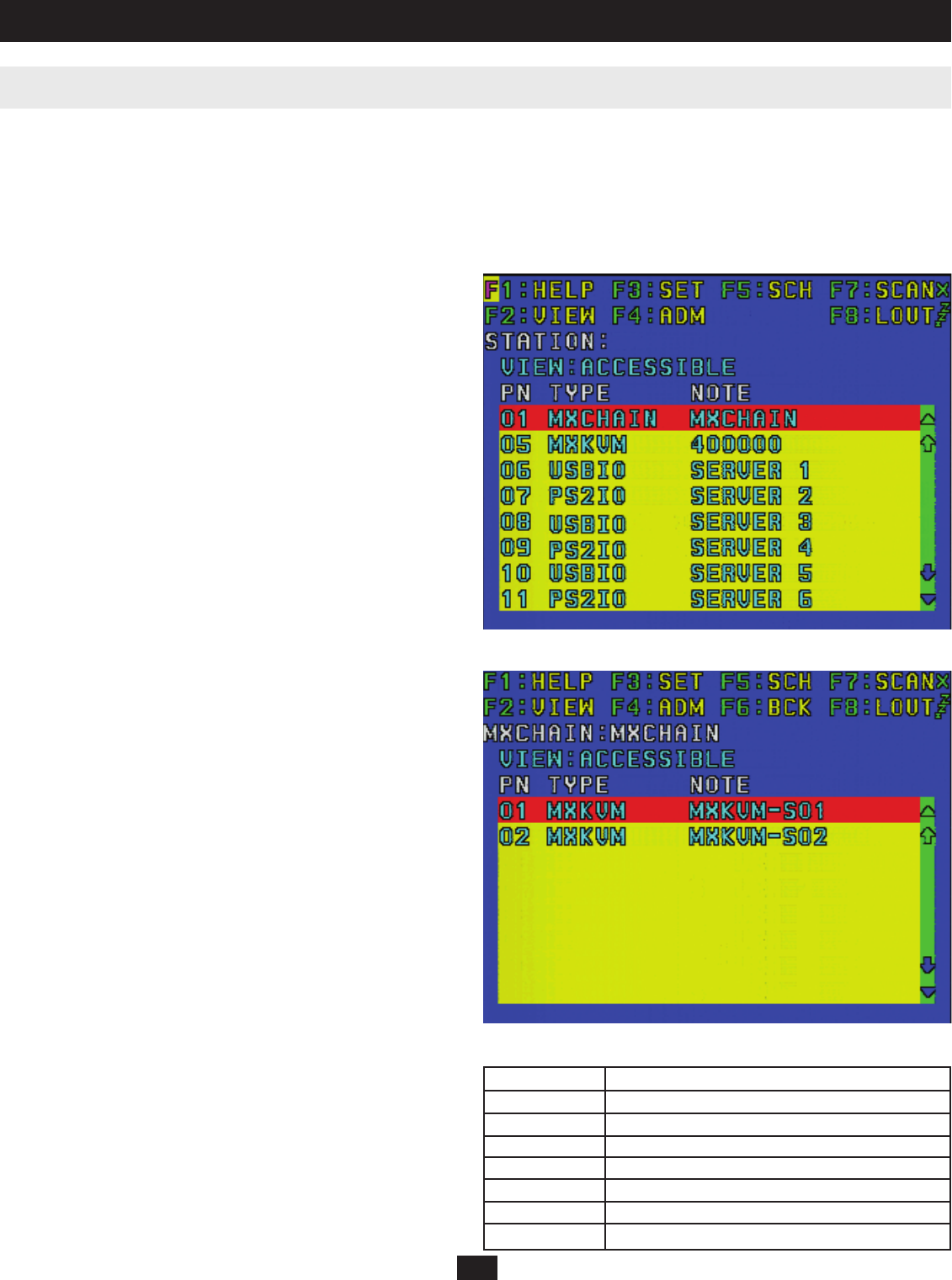
38
11. OSD Operation
11.3 Accessing Switches & Computers
To access a computer, cascaded switch, or daisy-chained switch, double-click it; or, move the highlight bar to it and press ENTER. If more than one user
tries to access a KVM port at the same time, the fi rst user to gain access controls the KVM port, while the other users can only view it. If the controlling user
exits the KVM port, the second user gains control. Control of the port can also be taken over once the controlling user’s Idle Timeout time is up.
Single-Level Installation OSD Access
In a single level installation there are no additional switches cascaded or daisy-chained from the B060-032-8. The port list will show all the ports of the
B060-032-8.
Cascaded Installation OSD Access
In a cascaded installation the default port list will show MXKVM in the
TYPE column next to its port number, and station note in the NOTE
column next to the model number (Figure 41).
Daisy-Chained Installation OSD Access
In a daisy-chained installation the default port list will show MXCHAIN
in the TYPE column and MXCHAIN in the NOTE column (Figure 40).
Double-click port 01, or move the highlight bar to it, and then press ENTER
to view a list of the daisy-chained switches in the installation (Figure 42).
A maximum of seven additional B060-032 or B060-016-2 switches can be
daisy-chained from the fi rst level B060-032-8. Note: In a daisy-chained
installation, KVM ports 1–4 on the fi rst-level B060-032-8 cannot be used.
Do not connect any switches or server interface units to these ports.
Port ID Numbering Convention
Each KVM port in the KVM installation has a unique port ID. The port ID
is composed of up to three port numbers separated by hyphens. These port
numbers describe a path from the fi rst-level KVM switch through the KVM
installation to the target device. In Hotkey mode (page 44) you can type a
port ID to switch directly to any KVM port in the installation.
Cascaded Installation Port IDs
The port numbers that comprise the port ID in cascaded installations are
displayed in the following order from left to right:
1. The port number of the fi rst-level B060-032-8.
2. The port number of the second-level KVM switch (if applicable).
3. The port number of the third-level KVM switch (if applicable).
For example, a computer attached to Port 3 of a third-level KVM switch,
which is cascaded from Port 6 of a second-level B060-032-8, which is
cascaded from Port 15 of the fi rst-level B060-032-8, would have a port ID of
15-6-3. (This can also be typed 15-06-03.)
Daisy-Chained Installation Port IDs
The port numbers that comprise the port ID in daisy-chained installations are
displayed in the following order from left to right:
1. “1” will always be the fi rst number in a daisy-chained KVMs Port ID.
2. The position of the B060-032 or B060-016-2 Matrix KVM Switch
in the daisy chain. You can determine the position of the B060-032 or
B060-016-2 in the daisy-chain by subtracting 1 from its station ID.
For example, the station ID of the fi rst B060-032 or B060-016-2 in the
daisy-chain is 2. (2 - 1 = 1) The B060-032 or B060-016-2’s position in the
daisy-chain is 1. The table below lists the B060-032 or B060-016-2’s station
ID and its position in the daisy-chain.
3. The port number on the B060-032 or B060-016-2.
For example, a computer attached to Port 18 of a B060-032, which is in
Position 7 in the daisy-chain (Station ID 8), which in turn is daisy-chained
from the fi rst-level B060-032-8, would have a port ID of: 1-7-18.
Figure 41: OSD Main Screen (Cascaded Installations)
Figure 42: OSD Main Screen (Daisy-Chained Installations)
Station ID Position in the Daisy Chain
2 1
3 2
4 3
5 4
6 5
7 6
8 7
